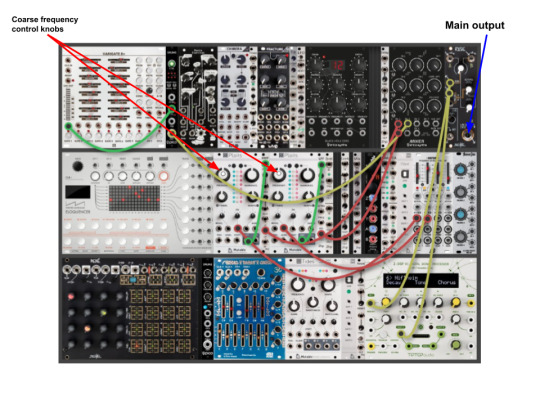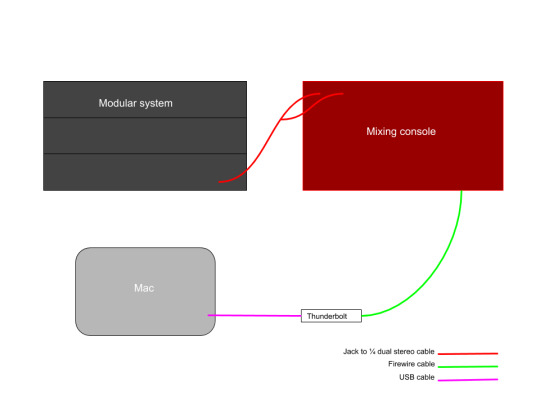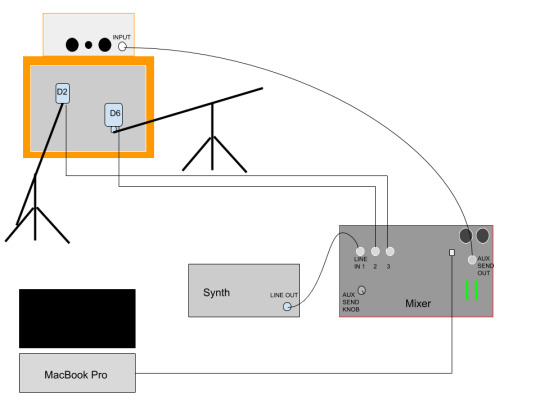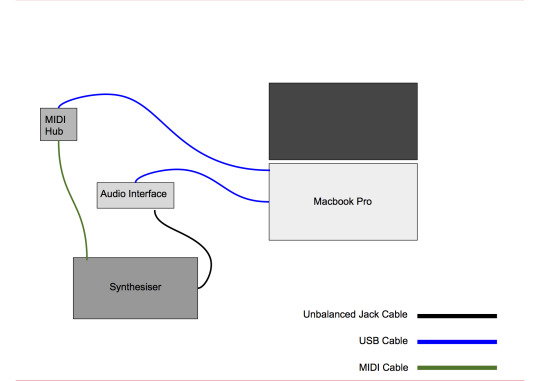Don't wanna be here? Send us removal request.
Text
Summary
In conclusion, this blog displays a range of hardware and instruments, which were explored and used to come up with innovative production approaches such as multitrack recordings and live jams, as well as capturing recordings from hardware instruments and making use of the recorded material to come up with compositional ideas in Ableton.
Analyzing production methods or equipment was essential to get more familiar with the hardware and gain a more fluent production workflow. Some hardware was challenging to make use of, looking up the user manual on the internet was typically the key to finding the solution. The outcome of module workshop sessions and additional studio time are two finished compositions that were composed utilizing contrasting production styles.
Reflecting on the blog as a summary of my own experience, I discovered that some of the outcomes from the sessions were not particularly suitable for the final compositions but perhaps still will be an essential part of productions in the future. I am more comfortable around hardware equipment and believe that I have explored powerfull production methods, contributing to a strong set of skills that will help me generate new creative ideas for electronic music production.
0 notes
Text
Composition 2 - Multitrack Recording
Follow the link to view the composition 2 evaluation videos: https://drive.google.com/open?id=1boxVLgL_ONnpjjLLQnq57806pLhYDsVQ
The suggested running order for the videos:
1. SETUP REVIEW
2. MIDI/AUDIO SETUP
3. F1 MAPPING
(Diagram displaying the hardware setup)

0 notes
Text
Exploring the modular system

(The diagram above displays the drone patch)
Drone Patch
To receive an audio signal from both VCO's, it was essential to route the outputs to the mixer. Connecting the output of the mixer to the A input of the Rosie enabled me to route the audio signal to the mixing console. Using the send and return of the Rosie, enabled me to send the main output of the mixer to the reverb and blend it into the mix.
Connecting the Batumi low-frequency oscillator sine outputs to the FM and Timbre CV inputs of the Plaits VCO’s made it possible to modulate their pitch. Feeding the CV sine output of the Batumi to the Model gate input of a chosen VCO can modulate its time by cycling through two sound banks of eight models. (Mutable Instruments , User manual:1).
Modular live jam
In contrast to the previous session, where the Varigate 8+ was used to trigger a drum module by sending out gate information, the CV outputs were routed to the CV input of the 0-Coast to control the pitch.
The CV edit mode(indicated when the CV page button is red) of the ELOQUENCER offers an easy and quick way to change the notes by selecting individual steps for half a second and subsequently turning the DATA knob (Winter Modular, 2019:6).
Find the videos of the session in the link below:
https://drive.google.com/open?id=11cV1dk00vX2mED_IETOzEVc5u9F2Ki20

(Diagram of the audio routing setup)
Using the modular system inspired me to think about how music production could be approached differently in the future. Having knobs and buttons in front of me felt much more like playing a musical instrument. Physically shaping the music felt very tangible, which was much more exciting than working on a computer as some decisions resulted in happy accidents.
In an interview on YouTube, Techno Producer Headcell talks about his experience with modular hardware to produce his music (YouTube, 2017:1). It appears to be that other famous Techno producers, Like Benjamin Damage, also use indistinguishable production styles. This can be distinguished when listening to Len Faki - Robot Evolution (Benjamin Damage Live Remix) (YouTube , 2019:1).

(Picture of a more complex modular patch, demonstrating the progress from my previous setup)
Follow the link to hear a demo of me using the system in the picture above: https://drive.google.com/open?id=19n_Mw8pO21RnkjfHaX6t0nAvFySeXkj2
0 notes
Text
Advanced audio routing using external effects

(Diagram of the audio signal routing)
The colored arrows indicate which auxiliary send knobs on channels one and two have to be turned up. Turning up aux one on channel one and aux two on channel two will send the signal from both channels to the master auxiliary sends one and two. Sending the signal from channel one and two to the auxiliary master sends three and four, can be done by turning up the knobs indicated by the pink and orange arrows.
The auxiliary master sends one and two will allow the signal to pass-through to MidiVerb.On the other hand, the auxiliary sends three and four can be used to let the signal pass through to Lexicon. The processed signal will return to the stereo bus one and two after the effects. Turning up the stereo buss one will allow us to blend the MidiVerb into the mix and vice versa. Both stereo buses will enable us to pass the processed signal through to channels one and two. At the top of each bus, we can select which channels the stereo signal will arrive in the DAW.
0 notes
Text
Kick drum patch using CV routing

(Picture of the 0-Coast patching)
To synthesize a kick drum using the 0-Coast, we need to change the routing of the 0-Coast’ s circuit. Kick drum synthesis always starts by modulating the pitch of a pure waveform to create a sweep. We can use the Slope by patching its CV output to the Line FM input of the oscillator. Slope controls the voltage amplitude over time to modulate the functionality of the 0-Coast. Turning the slope cycle on ‘creates a continuous Function starting at 0V, traveling up to 8V, and then immediately beginning the descent back to 0V, repeating this behavior until the Cycle Button is [pressed] again to disengage Self-Cycle’ (Make Noise ,2019 :24). This function is also known as a low-frequency oscillator or LFO. The Line FM CV input control knob will allow us to decide how much pitch modulation the oscillator receives from the slope. This function also controls the impact of the modulation.
The EDC (Slope: End of Cycle) gate output controls the movement of multiply overtime when patched to the Multiply CV input. The Balance control in the top right-hand corner of the unit enables us to decide how much overtone is applied to the fundamental waveform of the kick. This also includes the Multiply amount (the multiplier multiplies the frequency of the overtone). Both overtone and multiply can be used to alter the timbre of the 0-Coast.

(Screenshot displaying the kick drums recorded using the patch explained previously)
0 notes
Text
Re-amping
This week I will be re-amping my Make Noise 0-COAST, using a combination of the Tiny Terror and a cabinet by Orange Amps. The Tiny Terror is a valve amp, also known as a vacuum tube amplifier. In contrast to amplifiers that use solid-state devices, such as transistors to produce electronic amplification, valves offer more texture and a richer midrange (Cary Audio, 2018:1). The microphones for the session will be the Audix D6 and Audix D2. Being dynamic microphones, they will enable me to record at a louder input level, meaning that the output level of the amplifier can be at a high volume. In combination, the two microphones are great for capturing a detailed mid-range recording, as well as transients.
In contrast to industry practices;
“It is a popular and widely used technique, although it is more common in the production of some musical genres than others.”(Sound on Sound , 2010:1)
the sound of harmonically rich and warm tones preserved when running an electric guitar through a valve amp always appealed exciting to me, coming from a background of playing in bands. After getting more into House and Techno, it became apparent that those genres are starting to sound more raw again. This can be heard in tracks such as Will Fossil - Zombie.
“Musically, now more so than ever, a lot of the music is definitely harping back to sort of the techno that I first got into during ‘92, ‘93, ‘94. It’s very rough and raw, and everything is getting a bit hard.”(Kocay , 2018:Eats Everything)
Running a synthesizer through the valve amp might enable me to adapt to that particular style of sound, which is becoming very popular again at the time, in future projects.
The link below will take you to an audio file of example kick drums;
https://drive.google.com/open?id=1iWflv_-QxEQ6uA7UVENK7QFQygkDx6_T
Re-amping Diagram

Audio routing
- Synth line out to mixer line in one
- Mixer channel one to aux send
- Aux send out to amp
- Mic D6 and D2 to mixer line in two and three
- Mixer USB out - MacBook pro USB in
0 notes
Text
Using the studio as an Instrument
To use the studio as an instrument, I have prepared a live jamming session that includes analog and digital hardware. The set up requires Ableton live, an analog drum machine (Arturia Drumbrute), a mono synth (Make Noise 0-Coast), as well as the Novation Launchpad and a Traktor F1. The Drumbrute and the 0-Coast receive a MIDI clock signal from Ableton live, this will keep the project in time.
I used the 0-Coast to record some kick and bass patterns as preparation for the session. Inserting the patterns to Ableton's session view will enable me to play the audio loops as scenes. The Drumbrute will be used to apply rhythmic elements around the ground beat.
The 0-Coast, on the other hand, will receive CC information from Ableton. Hands-on control over the synth as the jam is progressing will allow me to come up with creative ideas on the fly. Ableton sending CC information to the synth will allow me to program note patterns in MIDI clips to trigger the 0-Coast and use it for bass or percussive parts in the live jam.
0 notes
Text

This week I will record some analog synth into one of my projects. The equipment required to achieve this includes a MIDI hub, MIDI cable, an audio interface, and an unbalanced jack cable. The idea is to come up with a suitable bass pattern for my track by using the external instrument in Ableton by sending note information to my synth. This will enable me to tweak the parameters of the synth as the pattern is being recorded and will allow me to add human interference to the recording. The first thing I will need to do to capture the audio from my synth on to a new audio track in Ableton is to check that the right input source is selected in the live audio preferences. I will also need to make sure that “Audio From” (Ext. in) on the audio channel is selected. The audio signal from the synth will be coming into the channel and by arming the track I will be able to hear and record the sound.
0 notes
Text

In this week's blog post I am looking at the latest studio setup which I have used to play around and explore new musical ideas with. As for one of my two future compositions I am going to be working on my own, I decided to find a way of recording multiple Instruments at once to occupy more than one piece of hardware at the time and add a sense of human interference to the music. I have used Ableton to send CC information to the Korg Volca Keys and the Make Noise 0-Coast. CC (Continues Controller) is a MIDI message that sends values to the synths (Ableton , 2019:1). To integrate the hardware with Ableton live I used a MIDI interface which I connected to the MIDI inputs of the two synths. Next, I opened up the Ableton live MIDI preferences and enabled Track so that that the MIDI interface will be able to receive MIDI note and MIDI CC data. Now the MIDI information can be sent to the MIDI interface I created a new MIDI channel in Ableton and loaded up External Instrument. The External instrument will allow me to control the external hardware. On the external instrument, I selected the appropriate MIDI output port for the MIDI interface to receive the signal and pass it through to the hardware.
0 notes
Text

In my first blog post, I will talk about the Hardware set up of the first Hardware Production session this week. On Monday, I shared a studio with a classmate to have a jam, using the Vermona DRM1 MKIII, Roland JU-06, Novation Bass Station and Arturia Beatstep Pro. We used the Beatstep Pro as our master clock, passing on a MIDI clock signal to the MIDI in of the Vermona DRM1 MKIII. The MIDI out of the Vermona DRM1 MKIII was connected to the MIDI in of the Roland JU-06 and the Roland JU-06 was sending MIDI clock information to the Bass Station. That way all hardware was in sync and ready for a jam. A problem that occurred when connecting the hardware was that we couldn't send any CV/Pitch information to the synths and program patterns via the Beatstep Pro.
Bibliography
Winter Modular, (2019) Winter Modular Eloquencer Manual. [Online] Available from: http://winter-modular.com/wp-content/uploads/2018/05/Eloquencer_Manual_V1.2.0.pdf [accessed 6 December 2019]
Ableton , (2019) Using external hardware (with MIDI). [Online] Available from: https://help.ableton.com/hc/en-us/articles/209774265-Using-external-hardware [accessed 6 December 2019]
Cary Audio, (2018) VACUUM TUBE VS. SOLID-STATE. [Online] Available from: https://www.caryaudio.com/2018/06/04/vacuum-tube-vs-solid-state/ [accessed 6 December 2019]
RecordingHacks, (2008) Audix D6. [Online] Available from: http://recordinghacks.com/microphones/Audix/D6 [accessed 6 December 2019]
Make Noise , (2019 ) Modulation with Slope. [Online] Available from: http://www.makenoisemusic.com/content/manuals/0-coast_manual.pdf [accessed 6 December 2019]
Mutable Instruments , (User manual) 2019 . [Online] Available from: https://mutable-instruments.net/modules/plaits/manual/ [accessed 6 December 2019]
Kocay , L. (2018) Acclaimed DJs Share How Techno And House Music Has Changed. [Online] Available from: https://www.forbes.com/sites/lisakocay/2018/05/10/changing-music-industry-techno-house-dj/#4b59412a6ca6 [accessed 10 December 2019]
Sound on Sound , (2010) Q. How common is re-amping?. [Online] Available from: https://www.soundonsound.com/sound-advice/q-how-common-re-amping [accessed 10 December 2019]
YouTube , (2019) Len Faki – Robot Evolution (Benjamin Damage Live Remix). [Online] Available from: https://www.youtube.com/watch?v=kp51ZjKXrQ4 [accessed 10 December 2019]
Kocay , L. (2018) Acclaimed DJs Share How Techno And House Music Has Changed. [Online] Available from: https://www.forbes.com/sites/lisakocay/2018/05/10/changing-music-industry-techno-house-dj/#4b59412a6ca6 [accessed 10 December 2019]
YouTube, (2017) Drumcell: IDOW Extended Interview #3 (Modular Techno). [Online] Available from: https://www.youtube.com/watch?v=OxAUDtekWaA [accessed 10 December 2019]
1 note
·
View note